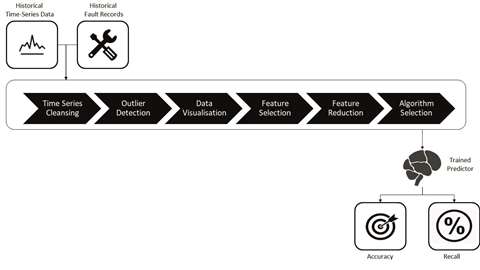Predictive maintenance: Get ready
11 October 2019
A colleague of mine recently toured a centralised digital operations centre for a global equipment rental company and made an interesting observation – there is a lot of telemetry information flooding into the centre from thousands of pieces of kit scattered across the globe. So much so that the service experts admitted that the information flow could be overwhelming, and it is hard to see the wood for the trees.
“This is great news!” I thought, as our new predictive maintenance solution needs large amounts of historical telemetry data, together with associated service records, to train the predictive algorithms.

Unfortunately, when we drilled into the telemetry data, we discovered that the equipment only transmitted a telemetry update on average once per hour, and this is too infrequent to predict most failure types that would severely impact the end customer.
We have too much equipment data for the people to process, but not enough for machine learning.
We also discovered equipment service records were being recorded on paper job tickets in the field before being transcribed to the rental management system by the back-office team. This manual data capture led to missing and poorly structured service records caused by poor handwriting, human error and lack of process compliance.
If rental equipment companies are implementing low-frequency telemetry solutions alongside paper-based service work orders, then they cannot realistically implement predictive maintenance.
This is a big problem because, as noted in a recent IRN article (June 2019) on the depot of the future, the customer journey of the near future demands pro-active customer service and minimal downtime.
Moreover, the key enabler to providing this advanced level of customer service is equipping your technical service centres with a predictive maintenance capability.
What is predictive maintenance?
Artificial Intelligence (AI) is the concept of machines being able to carry out tasks in a way that we would consider ‘smart’.
Machine Learning is a subset of AI, based around the idea that humans should give machines access to data and let them learn for themselves.
Predictive maintenance is a class of machine learning. Predictive maintenance algorithms evaluate the condition of equipment – through frequent sensor monitoring – and calculate the probability of failure.
Why implement predictive maintenance?
The tangible benefits of implementing predictive maintenance for an equipment rental company include:
- Higher customer satisfaction through identifying and resolving issues before they result in equipment downtime
- Reduced maintenance costs by reducing unnecessary field service visits to investigate non-critical matters
- Higher equipment utilisation by reducing unplanned downtime on customer sites
- Improved equipment performance by alerting when equipment productivity is dropping – which is often a precursor to machine failure
- Extended equipment life by reducing catastrophic failure and the subsequent impact on equipment components
The intangible benefits include:
- Steal a march on competitors by transforming customer service and equipment performance, differentiating your brand
- Adapt your business model using the technology to provide additional customer services
- Improve your supply chain by sharing part performance with OEMs and realigning incentives based on this data
- Attract a younger workforce by demonstrating a commitment to deploying cutting-edge machine learning technology and smart business processes across the business

Getting ready for predictive maintenance
The raw material for the successful implementation of predictive maintenance consists of two data streams: equipment telemetry and equipment service records.
Telemetry time series data
When you implement telemetry across your fleet, you will receive a time-series data stream per piece of rental equipment. Time-series data is a sequence of data points, measuring the same thing over time, stored in consecutive time order.
The things that a rental company might measure on high-value equipment with an onboard engine could include:
- Unique equipment identifier
- Current run status
- GPS location
- Run hours
- Fuel levels
- Fuel consumption rate
- Battery levels
- Output voltage and frequency
- Active power
- Power factor
- Operating temperature
It is vital that you capture all available telemetry information, as frequently as possible, to provide enough data to train the predictor.
Remember that this data is not for human analysis, so don’t worry about overwhelming your technical support team or overloading your storage capacity.
Equipment service records
An electronic service record should be created every time a depot or field service engineer interacts with the equipment.
A well-structured service record includes:
- Unique equipment identifier
- Faults discovered
- Reason for fault
- Any action taken
- Follow-on action required
- Parts used
- Time taken to conduct service – with unique employee identifiers
The more structured the service record, the easier it will be to train a predictor, and the more accurate the predictor will be.
If you are using paper-based field service tickets, or if your current process allows large text blocks to record fault and resolution information, then it will be considerably more difficult to implement predictive maintenance. If this is the case, you should urgently consider implementing a digital operations platform and use Apps designed for the rental industry to electronically capture structured field service data – integrated into your existing equipment rental management system where appropriate.
Implementing predictive maintenance
The process begins with an ‘offline’ training phase using a combination of the historical telemetry and service record data streams alongside domain expertise from equipment service specialists.
The combined data set is presented to subject matter experts, such as senior maintenance engineers, to label ‘good’ and ‘bad’ behaviour. Not all events need to be labelled; a representative sample proportional to the size of the historical data set will suffice.
Once the data set has been labelled, a sufficiently trained data scientist will generate, test and validate several predictor algorithms and propose a ‘winner’.
The winning algorithm will have the optimum combination of accuracy (ratio of genuine predicted failures versus false positives) and recall (the probability that an actual predicted failure is identified).
We are now able to implement the algorithm in a predictive maintenance solution. The solution should have (at least) the following capabilities:
- Real-time integration to live telematics sensor stream – for all equipment with installed telematics
- A simple and intuitive user experience to alert service technicians of probable failure or sub-optimal operation across all equipment in the fleet
- The ability to raise an urgent intervention to automatically create a service work order in the rental management system for rapid planning and execution. Speed is essential to resolve the issue before a catastrophic problem occurs with resulting downtime and cost
- The ability for service technicians to open the profile of any piece of equipment and label behaviour. This is crucial for re-training future generations of predictor algorithms
Once implemented, you will have a real-time failure prediction and rapid response capability across all telematics-enabled equipment in your fleet.
Conclusion
The rental industry has many of the raw materials in place to quickly implement predictive maintenance.
Telematics is increasingly being used to track and monitor higher value, more sophisticated equipment. Most medium to large rental companies have implemented rental management systems to, among other things, manage equipment servicing.
There will undoubtedly be challenges around data quality and completeness, but there are proven digital operations solutions with specialist mobile Apps designed to support rental servicing – in the depot and the field.
The business impact of implementing predictive maintenance is potentially massive, as we have seen first-hand in the oil and gas sector.
The sooner people get ready for predictive maintenance, the faster the rental industry can achieve these benefits and become a leader in next-generation technology.

About the author
John Glen is co-founder and Chief Financial Officer of software company Spartan Solutions (spartansolutions.com). A technologist since his early teens, Glen says his passion is to build great teams that build great software. His latest project is the launch of a new predictive maintenance solution that will democratise the use of predictive analytics and mobile operations, and revolutionise the performance of industrial assets, equipment and technicians.




